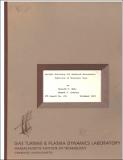| dc.contributor.author | Hall, Kenneth C. | en_US |
| dc.contributor.author | Crawley, Edward F. | en_US |
| dc.contributor.other | United States. National Aeronautics and Space Administration | en_US |
| dc.contributor.other | Massachusetts Institute of Technology. Gas Turbine and Plasma Dynamics Laboratory | en_US |
| dc.contributor.other | Lewis Research Center | en_US |
| dc.date.accessioned | 2016-10-06T21:22:02Z | |
| dc.date.available | 2016-10-06T21:22:02Z | |
| dc.date.issued | 1983 | en_US |
| dc.identifier.uri | http://hdl.handle.net/1721.1/104699 | |
| dc.description | Carried out in the Gas Turbine and Plasma Dynamics Laboratory, MIT, supported by the NASA Lewis Research Center under grant NSG-3079 | en_US |
| dc.description | November 1983 | en_US |
| dc.description | N84-16180 --Microfiche header | en_US |
| dc.description | Bibliography: p. 94-96 | en_US |
| dc.description.abstract | An inverse design procedure was developed for the design of a mistuned rotor. The design requirements are that the
stability margin of the eigenvalues of the aeroelastic system be greater than or equal to some minimum stability margin, and
that the mass added to each blade be positive. The objective was to achieve these requirements with a minimal amount of
mistuning. Hence, the problem was posed as a constrained optimization problem. The constrained minimization problem
was solved by the technique of mathematical programming via augmented Lagrangians. The unconstrained minimization phase of this technique was solved by the variable metric method of Broyden, Fletcher, and Shanno.
The bladed disk was modelled as being composed of a rigid disk mounted on a rigid shaft. Each of the blades were
modelled with a single tosional degree of freedom. Adamcyzk and Goldstein's linearized aerodynamic model for the unsteady
moment coefficients in a supersonic cascade was applied at the typical section. The resulting non-self-adjoint eigenvalue
problem is of the form Aq = XBq. The eigenvalues and eigenvectors of this eigenvalue problem were found by a
fourth-order Runge-Kutta line integration of the derivatives of the eigenvalues and eigenvectors.
It was shown that mass mistuning does not introduce damping into the system, and that a necessary but not
sufficient condition for stability is that the blade be self damped. The results of the optimization showed that an
optimally mistuned rotor can achieve a given stability margin for a much lower level of mistuning than alternate mistuning. However, it was shown that optimal mistuning is sensitive to errors in mistuning. Small errors in the implementation of
optimal mistuning can severely reduce the gains in stability achieved by optimal mistuning. Alternate mistuning, on the
other hand, is relatively insensitive to errors in mistune. | en_US |
| dc.format.extent | 1 v. | en_US |
| dc.publisher | [Washington, D.C.? : National Aeronautics and Space Administration, 1983] | en_US |
| dc.relation.ispartofseries | N 84-16180 | en_US |
| dc.relation.ispartofseries | NASA contractor report ; NASA CR-173179 | en_US |
| dc.relation.ispartofseries | GT & PDL report ; no. 176 | en_US |
| dc.subject.lcc | TJ778.M41 G24 no.176 | en_US |
| dc.subject.lcsh | Aeroelasticity -- Mathematical models | en_US |
| dc.subject.lcsh | Flutter (Aerodynamics) -- Mathematical models | en_US |
| dc.subject.lcsh | Aerodynamics, Transonic -- Mathematical models | en_US |
| dc.title | Optimal mistuning for enhanced aeroelastic stability of transonic fans | en_US |
| dc.type | Technical Report | en_US |
| dc.identifier.oclc | 68920570 | en_US |
